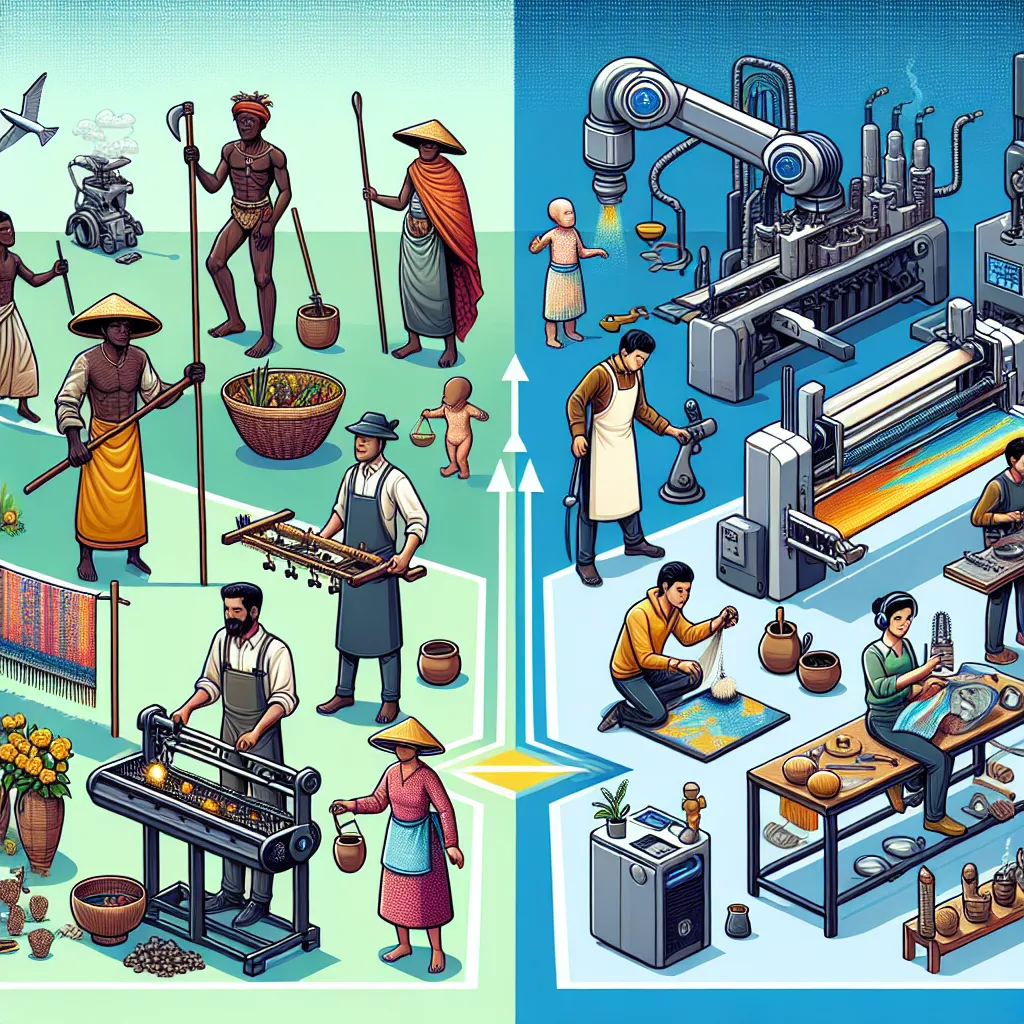The IELTS Reading section is a crucial component of the test, assessing your ability to comprehend complex texts and extract relevant information. Today, we’ll focus on a topic that has been increasingly prevalent in recent years: “The Impact of Technological Change on Employment”. This subject has appeared in various forms in past IELTS exams and, given its relevance in our rapidly evolving world, is likely to resurface in future tests.
Based on our analysis of past IELTS exams and current global trends, we predict a high probability of encountering passages related to technological change and its effects on the job market. Let’s dive into a practice exercise to help you prepare for this potential topic.
 Impact of technology on jobs
Impact of technology on jobs
Practice Reading Passage
The Shifting Landscape of Employment in the Digital Age
A. The dawn of the digital era has ushered in a period of unprecedented technological advancement, fundamentally altering the nature of work and reshaping the global job market. As automation, artificial intelligence, and machine learning continue to evolve at a rapid pace, traditional employment structures are being dismantled and reconstructed, leaving both opportunities and challenges in their wake.
B. One of the most significant impacts of technological change on employment has been the automation of routine tasks. Jobs that involve repetitive actions or predictable problem-solving are increasingly being taken over by machines and algorithms. This shift has affected a wide range of industries, from manufacturing to customer service. For instance, many factories now employ robotic systems to perform assembly line tasks that were once the domain of human workers. Similarly, chatbots and virtual assistants are gradually replacing human customer service representatives in many companies.
C. However, while some jobs are disappearing, new roles are emerging. The tech industry itself has created a plethora of positions that didn’t exist a decade ago, such as social media managers, data scientists, and cloud computing specialists. Moreover, the gig economy, facilitated by digital platforms, has given rise to flexible work arrangements and new entrepreneurial opportunities. Freelancers can now offer their services globally, and small businesses can reach international markets through e-commerce platforms.
D. The impact of technological change on employment is not uniform across all sectors and skill levels. High-skilled workers, particularly those in STEM fields (Science, Technology, Engineering, and Mathematics), have generally benefited from technological advancements. These professionals are often at the forefront of developing and implementing new technologies, and their skills are in high demand. Conversely, middle-skilled workers have faced more significant challenges. Many middle-income jobs, such as clerical work and certain manufacturing positions, are at risk of automation, leading to concerns about job polarization and income inequality.
E. Education and training systems are struggling to keep pace with the rapid changes in the job market. There is a growing skills gap between what employers need and what the workforce can offer. This mismatch has led to paradoxical situations where high unemployment rates coexist with a large number of unfilled job vacancies. To address this issue, there is an increasing emphasis on lifelong learning and continuous skill development. Many workers are finding it necessary to regularly update their skills or even retrain for entirely new careers to remain employable in the changing job market.
F. The geographical distribution of employment opportunities is also being reshaped by technological change. Digital technologies have enabled remote work on an unprecedented scale, a trend that has been accelerated by the COVID-19 pandemic. This shift has the potential to revitalize rural areas and small towns, as workers are no longer tethered to major urban centers. However, it also poses challenges for cities that have traditionally been hubs of employment and economic activity.
G. Looking to the future, the full impact of emerging technologies such as artificial intelligence, virtual reality, and biotechnology on employment remains to be seen. While these innovations promise to boost productivity and create new industries, they also have the potential to disrupt labor markets on a massive scale. Policymakers, businesses, and educational institutions must work together to ensure that the benefits of technological progress are broadly shared and that workers are equipped with the skills needed to thrive in the digital age.
H. In conclusion, the impact of technological change on employment is complex and multifaceted. While it presents significant challenges, particularly for certain categories of workers, it also offers opportunities for innovation, increased productivity, and new forms of work. The key to navigating this shifting landscape lies in adaptability, continuous learning, and a proactive approach to skill development. As we move forward, it is crucial to harness the potential of technology to create a more inclusive and sustainable job market for all.
Questions
Multiple Choice
-
According to the passage, which of the following is NOT mentioned as an effect of technological change on employment?
A) The creation of new job roles
B) The automation of routine tasks
C) The decrease in demand for high-skilled workers
D) The rise of the gig economy -
What does the passage suggest about middle-skilled workers?
A) They are benefiting the most from technological advancements
B) Their jobs are at a higher risk of automation
C) They are leading the development of new technologies
D) They are easily transitioning to high-skilled roles -
Which of the following best describes the relationship between technological change and geographical distribution of work?
A) Technology has made all work location-independent
B) Urban centers are becoming more important for employment
C) Remote work enabled by technology could revitalize rural areas
D) Geographical location no longer affects job opportunities
True/False/Not Given
Determine if the following statements are True, False, or Not Given based on the information in the passage.
-
Technological change has had a uniform impact across all employment sectors.
-
The gig economy has created new opportunities for freelancers to work globally.
-
High-skilled workers in STEM fields have generally benefited from technological advancements.
-
The COVID-19 pandemic has slowed down the trend of remote work.
Matching Headings
Match the following headings to the appropriate paragraphs in the passage. There are more headings than paragraphs, so you will not use all of them.
- Paragraph C
- Paragraph E
- Paragraph G
Headings:
I. The rise of new job categories
II. The challenge of updating educational systems
III. The potential impact of future technologies
IV. The decline of traditional manufacturing jobs
V. The global nature of the modern job market
VI. The importance of STEM education
Sentence Completion
Complete the following sentences using NO MORE THAN THREE WORDS from the passage.
-
Jobs involving ___ are increasingly being taken over by machines and algorithms.
-
The has given rise to flexible work arrangements and new entrepreneurial opportunities.
-
There is a growing between what employers need and what the workforce can offer.
-
To remain employable, many workers find it necessary to ___ or retrain for new careers.
Answer Key
-
C
Explanation: The passage mentions that high-skilled workers, particularly in STEM fields, have generally benefited from technological advancements. There is no mention of a decrease in demand for these workers. -
B
Explanation: Paragraph D states that “many middle-income jobs, such as clerical work and certain manufacturing positions, are at risk of automation.” -
C
Explanation: Paragraph F mentions that the shift to remote work “has the potential to revitalize rural areas and small towns.” -
False
Explanation: Paragraph D explicitly states that “The impact of technological change on employment is not uniform across all sectors and skill levels.” -
True
Explanation: Paragraph C mentions that “Freelancers can now offer their services globally” as a result of the gig economy. -
True
Explanation: Paragraph D states that “High-skilled workers, particularly those in STEM fields (Science, Technology, Engineering, and Mathematics), have generally benefited from technological advancements.” -
Not Given
Explanation: While the passage mentions that the COVID-19 pandemic has accelerated the trend of remote work, it does not provide information about slowing down this trend. -
I
Explanation: Paragraph C discusses the emergence of new job roles such as social media managers and data scientists. -
II
Explanation: Paragraph E focuses on the challenges faced by education and training systems in keeping up with rapid changes in the job market. -
III
Explanation: Paragraph G discusses the potential impact of emerging technologies like AI, virtual reality, and biotechnology on future employment. -
repetitive actions or
Explanation: Paragraph B states that “Jobs that involve repetitive actions or predictable problem-solving are increasingly being taken over by machines and algorithms.” -
gig economy
Explanation: Paragraph C mentions that “the gig economy, facilitated by digital platforms, has given rise to flexible work arrangements and new entrepreneurial opportunities.” -
skills gap
Explanation: Paragraph E states that “There is a growing skills gap between what employers need and what the workforce can offer.” -
regularly update their
Explanation: Paragraph E mentions that “Many workers are finding it necessary to regularly update their skills or even retrain for entirely new careers to remain employable in the changing job market.”
Common Mistakes
When tackling reading passages on technological change and employment, students often make the following mistakes:
-
Overgeneralizing: The impact of technology on jobs is complex and varies across sectors. Avoid assuming that all industries or job types are affected in the same way.
-
Misinterpreting cause and effect: Be careful to distinguish between the effects of technological change and other factors influencing employment.
-
Overlooking nuances: Pay attention to qualifying words like “some,” “many,” or “often.” These can significantly alter the meaning of statements.
-
Falling for distractors in multiple-choice questions: Options that sound plausible but are not supported by the text are common. Always refer back to the passage.
-
Mismanaging time: This type of passage often contains a lot of information. Practice efficient reading techniques to ensure you have enough time to answer all questions.
Vocabulary
Here are some key vocabulary items from the passage:
-
Unprecedented (adjective) – /ʌnˈpresɪdentɪd/ – never known or done before
Example: The digital era has brought unprecedented technological advancement. -
Dismantle (verb) – /dɪsˈmæntl/ – to gradually destroy or remove something
Example: Traditional employment structures are being dismantled by technological change. -
Plethora (noun) – /ˈpleθərə/ – a large or excessive amount of something
Example: The tech industry has created a plethora of new job positions. -
Paradoxical (adjective) – /ˌpærəˈdɒksɪkl/ – seemingly contradictory but possibly true
Example: High unemployment rates coexisting with many job vacancies is a paradoxical situation. -
Revitalize (verb) – /ˌriːˈvaɪtəlaɪz/ – to give new life or vigor to
Example: Remote work has the potential to revitalize rural areas.
Grammar Focus
Pay attention to the use of present perfect continuous tense in the passage:
“As automation, artificial intelligence, and machine learning have been evolving at a rapid pace, traditional employment structures are being dismantled and reconstructed.”
This tense is used to describe an action that started in the past, continues in the present, and may continue into the future. It emphasizes the ongoing nature of technological change and its effects on employment.
Structure: Subject + have/has been + verb-ing
Example: Technological advancements have been reshaping the job market for decades.
Tips for IELTS Reading Success
-
Practice active reading: Engage with the text by predicting content, asking questions, and summarizing main points.
-
Improve your vocabulary: Regularly learn new words related to technology, employment, and economic trends. Understanding context is crucial for the IELTS Reading test.
-
Time management: Allocate your time wisely. Spend more time on questions worth more points.
-
Skim and scan effectively: Use these techniques to quickly locate specific information in the passage.
-
Pay attention to transition words: Words like “however,” “moreover,” and “conversely” can signal important shifts in the argument or introduction of new ideas.
-
Practice regularly: Consistency is key. Try to read complex texts on various topics daily to improve your comprehension skills.
-
Review your mistakes: After each practice session, carefully analyze your errors to understand your weak areas and work on improving them.
Remember, success in the IELTS Reading test comes from a combination of strong vocabulary, effective reading strategies, and plenty of practice. Keep working on these areas, and you’ll see improvement in your performance.
For more practice on IELTS Reading, you might find our articles on the effects of technological change on employment and the impact of automation on job security helpful. These resources provide additional contexts and perspectives on how technology is reshaping the employment landscape.


